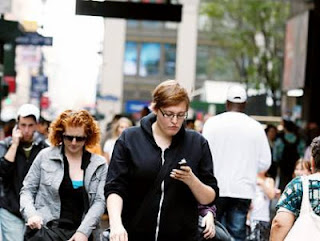A new report released today by the CalPIRG Education Fund with Frontier Group demonstrates that Americans have been driving less since the middle of last decade. The report, Transportation and the New Generation: Why Young People are Driving Less and What it Means for Transportation Policy shows that young people in particular are decreasing the amount they drive and increasing their use of transportation alternatives.Yesterday, the NY Times published an article about this year's report in the same vein, A New Direction, published by the federation of California's CalPIRG and other state Public Interest Research groups, U.S. PIRG. From the article, Young Americans Lead Trend to Less Driving:
People tend to drive less during recessions, since fewer people are working (and commuting), and most are looking for ways to save money. But Phineas Baxandall, an author of the report and senior analyst for U.S. Pirg, said the changes preceded the recent recession and appeared to be part of a structural shift that is largely rooted in changing demographics, especially the rise of so-called millennials — today's teenagers and twentysomethings. "Millennials aren't driving cars," he said.Okay, that last sounds just a wee bit overstated, but the report itself (PDF) does support the gist of Mr. Baxandall's generalization:
Sobering stuff: "anticipated reductions in the percentage of Americans in the labor force."
- Americans drove more miles nearly every year between the end of World War II and 2004. [...] By the end of this period of rapid increases in per-capita driving -- which we call the "Driving Boom" -- the average American was driving 85 percent more miles each year than in 1970.
- Americans drive no more miles in total today than we did in 2004 and no more per person than we did in 1996.
- On the other hand, Americans took nearly 10 percent more trips via public transportation in 2011 than we did in 2005. The nation also saw increases in commuting by bike and on foot.
- A return to the steady growth in per-capita driving that characterized the Driving Boom years is unlikely given the aging of the Baby Boom generation, the projected continuation of high gas prices, anticipated reductions in the percentage of Americans in the labor force, and the peaking of demand for vehicles and driver's licenses and the amount of time Americans are willing to spend in travel.
But what caught my eye in the NT Times article was this, from Michael Sivak of U. Michigan's Transportation Research Institute, referring to the proportion of young people who are signing up for driver's licenses:
Online life might have something to do with the change, [Sivak] suggested. "A higher proportion of Internet users was associated with a lower licensure rate," he wrote in a recent study. "This finding is consistent with the hypothesis that access to virtual contact reduces the need for actual contact among young people."I don't like the smell of that. Here's how the U.S. PIRG report described the relationship between virtual life and driving (bolded emphasis is mine):
Millennials are more likely to want to live in urban and walkable neighborhoods and are more open to non-driving forms of transportation than older Americans. They are also the first generation to fully embrace mobile Internet-connected technologies, which are rapidly spawning new transportation options and shifting the way young Americans relate to one another, creating new avenues for living connected, vibrant lives that are less reliant on driving.Urban and walkable neighborhoods? I'm all for that. I'm not a millennial by any stretch of the calendar, but I live and work in an urban and walkable city myself ... and I'd readily say that ability to get where I need to go without having to drive much at all is a top contributor to my day-to-day satisfaction.
But ... that business about mobile Internet-connected technologies: does that mean that if I'm strolling around my urban and walkable neighborhood, and you're strolling around yours, that we needn't actually meet face-to-face because the "vibrant lives" one can construct via Twitter, Skype, Tumblr and Facebook make actual social interaction superfluous?
Do. Not. Agree.
Coincidentally I half-heard a radio advertisement yesterday for some ATT internet service or other. I didn't transcribe the commercial, but the setup had a couple of (young-sounding) business dudes talking, on the phone I guess. One suggests meeting for coffee to discuss business dude stuff. The other -- smug and secure in the cradle of his high-bandwidth ATT intertube service -- declines. "I have a great connection," he says (or words to that effect). "We can meet on-line."
I admit it: I spend way too much time staring at my screens, both at work and at home. But I like to keep in mind (most of the time, anyway) the simple truth that digitally-mediated interaction ain't even a small fraction as rich, as satisfying, as informationally dense, or as socially weighty as your old, reliable F2F.
Don't you think?
Related posts on One Finger Typing:
If you don't want to drive you've got to be driven
Sharrows and stripes: bike lanes for a common good
Moving one's life to the cloud
Thanks to Thue via Wikimedia Commons for the image of a car wrecked in Copenhagen, Denmark; to Oldmaison (Charles Le Blanc) for the image of texting while walking (via Flickr); and John C. Abell for the image of @LenaGroeger and @Ericc29 @wired in at #nextwork (via Flickr).







No comments:
Post a Comment
Note: Only a member of this blog may post a comment.